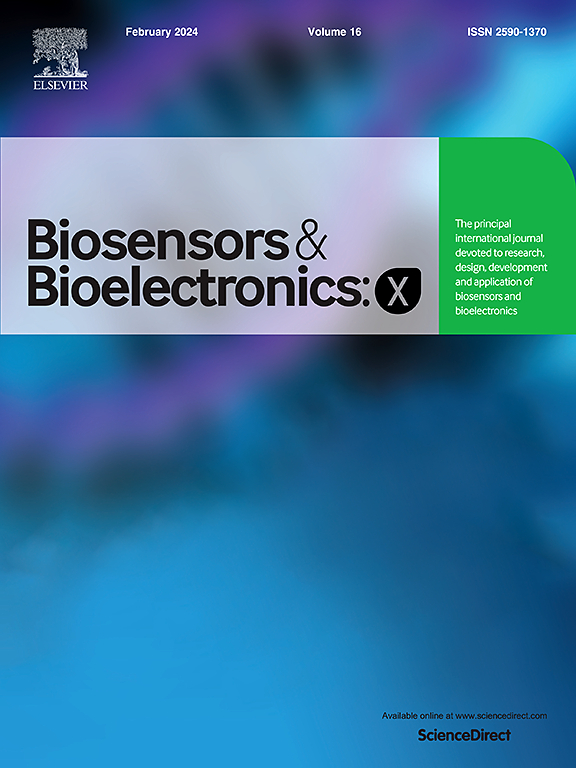Imatinib detection by memristive biosensors for therapeutic drug monitoring
IF 10.61
Q3 Biochemistry, Genetics and Molecular Biology
引用次数: 0
Abstract
Therapeutic drug monitoring is essential for optimizing the efficacy and safety of targeted anticancer agents like imatinib, a first-line treatment for various leukemias and gastrointestinal stromal tumors. This study introduces a novel memristive biosensor designed for the detection of imatinib. The biosensor employs a silicon nanowire (SiNW) -based memristive architecture integrated with a single-stranded DNA (ssDNA) aptamer as the bio-recognition element. The detection of imatinib concentration is successfully demonstrated in both buffer and human plasma. Kinetic analysis reveals that the analysis time for achieving binding equilibrium and measurement is within 10 min. Comprehensive linear response over Imatinib concentrations in human plasma ranging from 0.2 μM to 20 μM was achieved, with a detection limit of 0.13 μM. While the interfering proteins such as human serum albumin (HSA) and α1-acid glycoprotein (AGP) compete with the binding mechanism, resulting in a decreased measured signal at lower concentrations of imatinib, their excessive presence paradoxically amplifies the measured signal. This amplification, however, also introduces increased variability in plasma measurements. This innovative memristive biosensor represents a significant advancement towards point-of-care therapeutic drug monitoring. It offers a robust and scalable platform, paving the way for the integration of personalized medicine into routine clinical workflows for imatinib-based therapies.
记忆体生物传感器检测伊马替尼用于治疗药物监测
治疗药物监测对于优化伊马替尼等靶向抗癌药物的疗效和安全性至关重要,伊马替尼是各种白血病和胃肠道间质肿瘤的一线治疗药物。本研究介绍了一种用于检测伊马替尼的新型记忆体生物传感器。该生物传感器采用基于硅纳米线(SiNW)的忆阻结构,集成单链DNA (ssDNA)适体作为生物识别元件。在缓冲液和人血浆中成功地检测了伊马替尼的浓度。动力学分析表明,该方法可在10 min内实现结合平衡和测量,对人血浆中伊马替尼浓度在0.2 μM ~ 20 μM范围内实现全面线性响应,检出限为0.13 μM。虽然干扰蛋白如人血清白蛋白(HSA)和α1-酸性糖蛋白(AGP)与结合机制竞争,导致在低浓度伊马替尼下测量信号减弱,但它们的过量存在却矛盾地放大了测量信号。然而,这种放大也增加了等离子体测量的可变性。这种创新的记忆体生物传感器代表了护理点治疗药物监测的重大进步。它提供了一个强大且可扩展的平台,为将个性化医疗整合到伊马替尼治疗的常规临床工作流程中铺平了道路。
本文章由计算机程序翻译,如有差异,请以英文原文为准。
求助全文
约1分钟内获得全文
求助全文
来源期刊

Biosensors and Bioelectronics: X
Biochemistry, Genetics and Molecular Biology-Biophysics
CiteScore
4.60
自引率
0.00%
发文量
166
审稿时长
54 days
期刊介绍:
Biosensors and Bioelectronics: X, an open-access companion journal of Biosensors and Bioelectronics, boasts a 2020 Impact Factor of 10.61 (Journal Citation Reports, Clarivate Analytics 2021). Offering authors the opportunity to share their innovative work freely and globally, Biosensors and Bioelectronics: X aims to be a timely and permanent source of information. The journal publishes original research papers, review articles, communications, editorial highlights, perspectives, opinions, and commentaries at the intersection of technological advancements and high-impact applications. Manuscripts submitted to Biosensors and Bioelectronics: X are assessed based on originality and innovation in technology development or applications, aligning with the journal's goal to cater to a broad audience interested in this dynamic field.
 求助内容:
求助内容: 应助结果提醒方式:
应助结果提醒方式:


